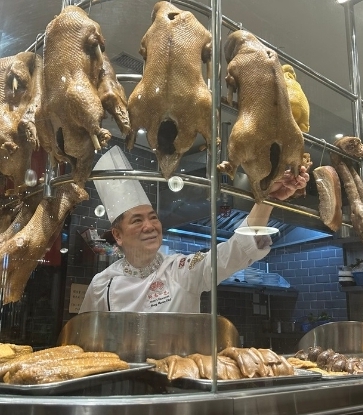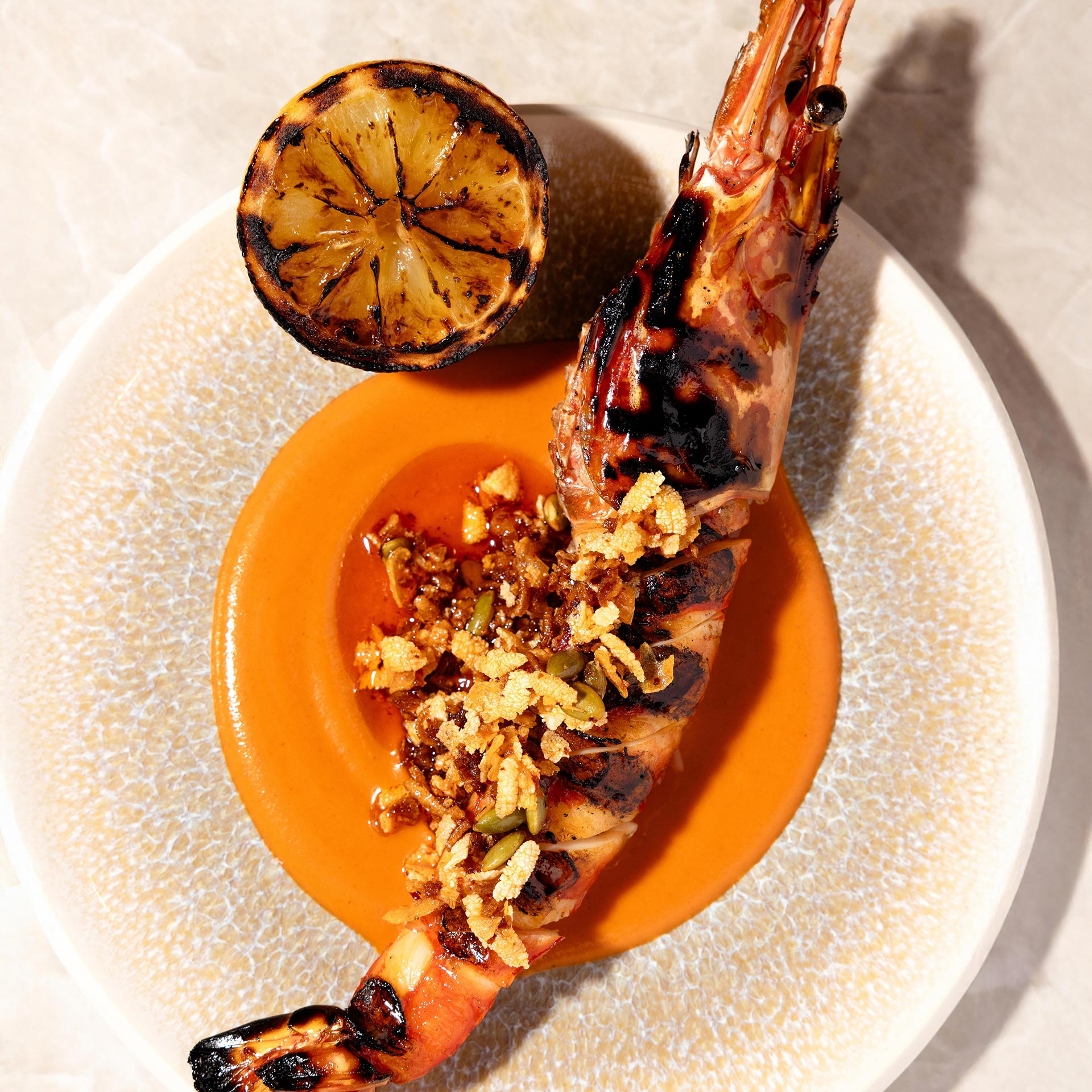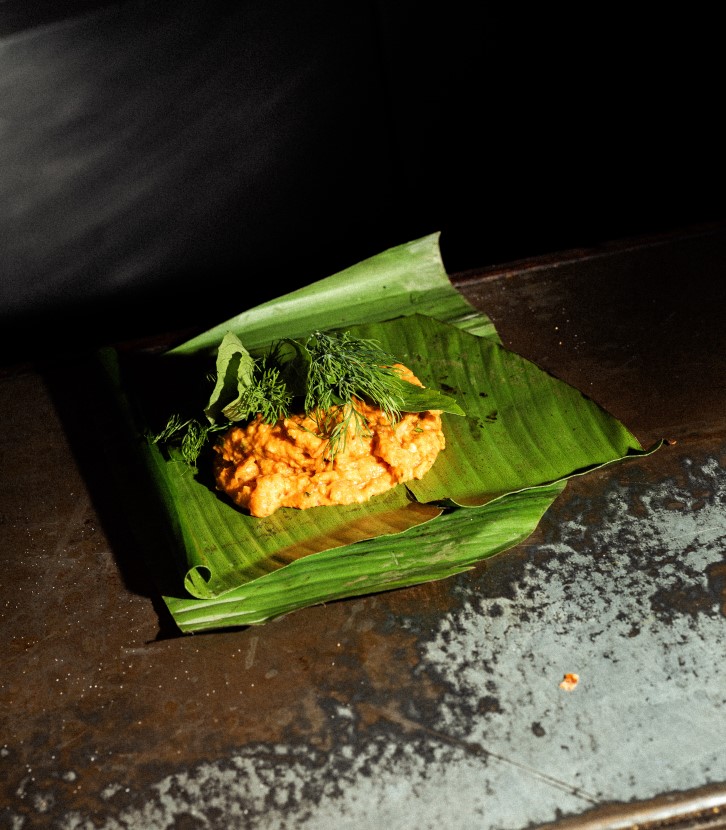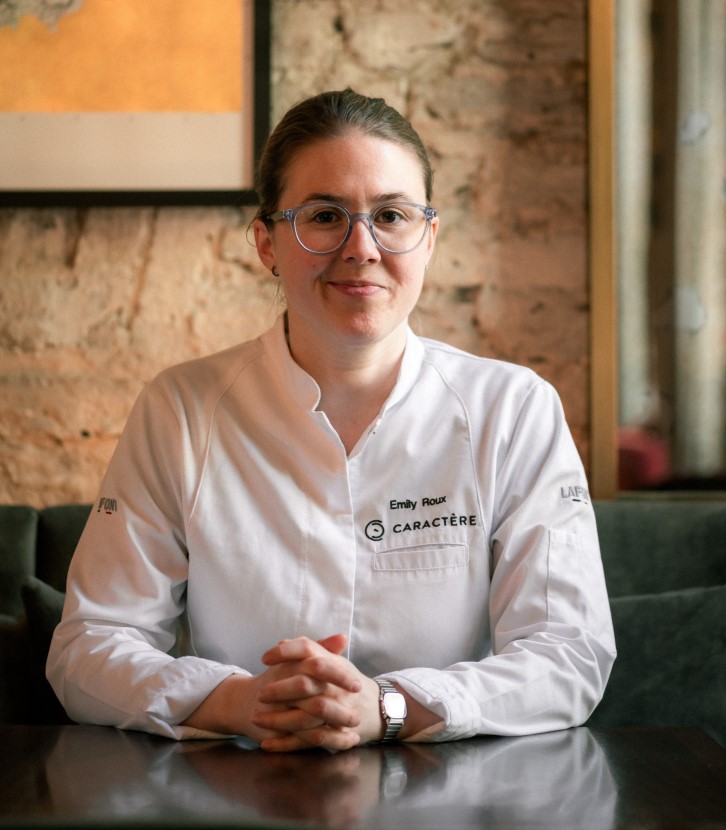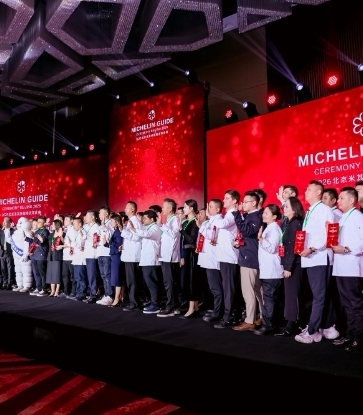The MICHELIN Guide Hong Kong Macau 2022 revealed a diverse selection of MICHELIN-starred restaurants, where chefs were recognised for expressing flavours of their respective culinary cultures with finesse, originality and creativity.
From Indian, Venezuelan, Singaporean to Korean, these new MICHELIN-starred restaurants pay homage to the gastronomic traditions that the chefs were brought up in, providing a portal into the cultural significance their cuisines represent.
Lucky for us, we can get a taste of these unique, multicultural flavours in our backyard. Here are some of the chefs’ favourite dishes from home—revived and reimagined—that you can try at their restaurants.

Chaat
One MICHELIN Star, MICHELIN Guide Hong Kong MacauDish: Jalebi
Jalebi, a popular sweet snack on the streets of India, is “a dish that unites India.” Made with deep-fried fermented batter in spiral shapes and soaked in sugar syrup, jalebi is crispy on the outside, chewy on the inside, and oozes saffron-infused with every bite.
“Jalebi breaks all the social barriers as it’s loved and enjoyed by everyone, from street dwellers to the royals in their palaces,” shares chef Manav Tuli of one-MICHELIN-starred Chaat. “The simplicity of its ingredients and low cost make it accessible to everyone.”
At Chaat, jalebi is a special item on the Taste of India menu—available only on the first and last Friday of each month—which comes with a condensed-milk-based dip called rabri. Tuli’s version of the jalebi is thin and Rajasthani-style, while the rabri is whipped and light in texture.
“My dad always says, ‘If you have a jalebi with rabri, it comes calorie free,” he jokes.
Tuli wants his guests to feel the same sentiment of joy that jalebi brought him and his family. “It's one of the best feelings from one of the most compounded yet simple Indian desserts—a beautiful example of execution evolved through generations of practice and unwavering desire to please people.”
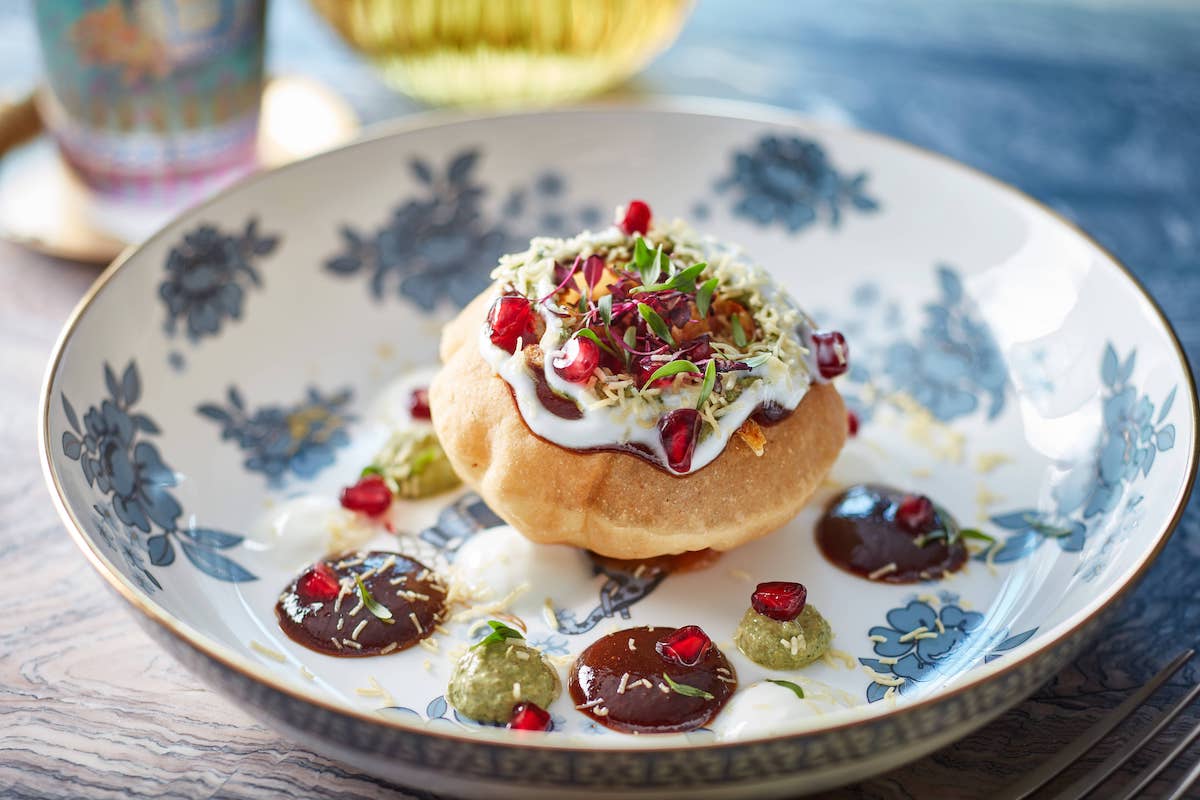
Dish: Atom Bomb Chaat
Describing Atom Bomb Chaat as “the big daddy of Raj Kachori,” Tuli grew up eating this chaat (savoury street snack) in his hometown Bhilai in central India. Five times bigger than a Raj Kachori, Atom Bomb Chaat is a deep-fried shell stuffed with ingredients such as onion, tomato, chickpeas, and all types of crisps, crushed samosa, crushed kachori, and aloo tikki.
As the name suggests, Atom Bomb Chaat is often the biggest dish on the menu. “I would never be able to finish it and my dad would wait for me to give up and help me finish it,” he recalls.
“This dish shows the beauty of India as a country with an abundance of many different cultures. Each bite is different and a dish in itself, just like how the Indian cuisine varies from city to city.”
Tuli’s own take on Atom Bomb Chaat, Raj Kachori has been a signature starter at Chaat since the opening. Rather than splashing chutneys all over the Raj Kachori, Tuli preserves the crispiness of the shell by placing the chutneys on top and around it as garnish. For the fillings, chickpeas are replaced with crispy lentil to add an extra layer of crunch.
“It’s one of the most complex dishes in terms of taste and texture on our menu. It’s a dish that is sweet, salty, sour, umami, spicy, crispy, soft, dry and moist all at the same time. It's an explosion of flavours in the mouth and sharpens one's desire for more food—a perfect way to start your meal at Chaat.”
RELATED: Let's Chaat: The MICHELIN Guide To Indian Street Food

Mono
One MICHELIN Star, MICHELIN Guide Hong Kong Macau
Dish: Arepas Reina Pepiada
Considered the national dish of Venezuela, arepa is typically a breakfast dish that is stuffed with ham and cheese, or reina pepiada, which is an avocado and chicken salad mixed with lemon, lime and coriander.
“Arepa is like a hug from your mother or grandmother,” says chef Ricardo Chaneton of one-MICHELIN-starred Mono. “It’s a delicious dish that my mum would prepare at home for me to bring to school. You can smell it when you’re holding it in the car, but you can only eat this beautiful piece of arepa during recess at school. Everytime I have arepas I am reminded of where I came from.”
Aprea is an ancestral bread made with a native South American ingredient—corn. “Arepa is a movement, a culture, a dish that sustains many communities in Spanish culture. It can be enjoyed at any moment of the day, at any celebration, at any occasion. Arepa is always the answer.”
Made with the same ingredients as a traditional aprea, Mono’s version is elevated with crab meat and sea urchin from Hokkaido. “Our arepa is served at the beginning of the meal—the same way we serve arepas to welcome someone home in Venezuela,” he shares.
RELATED: Ricardo Chaneton On His "Destiny" To Open Mono In Hong Kong

Dish: Cachapas
Cachapa may be a lesser known dish compared to arepa, it’s a dish that is enjoyed by Venezuelans on the weekend when families are out and about, whether in the city or the mountains.
Typically made with ground fresh corn—instead of corn flour—and stuffed with cheese, the cachapa at Mono is reimagined with a slice of abalone cooked at a low temperature to replicate the texture of queso de mano, a soft, white Venezuelan cheese commonly used as a filling for arepas and cachapas.
Another beloved dish from home that Chaneton would like to recreate is asado negro, a beef stew slow cooked in a black sauce, where the meat is coated in a dark colour that comes from burnt brown sugar, Papelón or malt. It is traditionally served with rice and sweet plantain fries—you heard it here first.

Whey
One MICHELIN Star, MICHELIN Guide Hong Kong Macau
Dish: Bak Kut Teh
“Nothing beats a piping-hot bowl of bak kut teh when it comes to the ultimate comfort food in my hometown. It warms your soul on a rainy day and recharges your body on a fine sunny day,” says chef Barry Quek of one-MICHELIN-starred Whey. Born and raised in Singapore, Quek has fond memories of visiting hawker centres for “delicious yet affordable eats at very convenient locations.”
As Hokkien, Quek explains that bak kut teh was introduced from China by Hokkien immigrants, many of whom were chefs and “cooked what they knew from China.” Teochew Bak Kut Teh is a clear peppery soup simmering with meaty pork ribs, white pepper and garlic. It’s typically accompanied by steamed rice, vegetables and fried dough sticks.
Whey’s version is described as “a deconstructed version of the bak kut teh with a personal touch.” Pork ribs from the New Territories’s Ying Ming farm are charcoal-grilled and served with pork heart, and cabbage served in two ways (oven-roasted and fermented), finished with a black garlic jam on the side and a drizzle of homemade pepper jus. It comes with a salad with fresh local herbs and pickled jicama to balance the dish.

Dish: Nyonya Laksa
Another dish that reminds Quek of home is Nyonya laksa, also known as curry laksa, which he describes as “a total flavour bomb.” A perfect comfort food that has a rich umami coconut milk soup base with a flavourful balance of spices and herbs, some of the common toppings for Nyonya laksa include prawns, eggs, deep-fried tofu, beansprouts and a spoonful of sambal chili pastes on the side.
At Whey, Quek transforms the traditional laksa noodle soup into curry laksa konjac rice topped with grilled lobster and house-made sambal sauces. A mix of chili peppers, blue gingers, garlic, dried shrimp and tamarind mixed in for a rich and robust taste. “There’s something about the sauce coating every grain that makes it so satisfying, mouthful after mouthful,” he says.
Quek adds that another Singaporean classic that he always has cravings for—and hopes to introduce to his guests at Whey—is Nasi Lemak, which consists of fragrant rice cooked in coconut milk and pandan leaf, served with sambal, egg, anchovies and a side of fried chicken.

Hansik Goo
One MICHELIN Star, MICHELIN Guide Hong Kong Macau 2022
Dish: Sundubu-jjigae
When it comes to soul-warming foods from home, sundubu-jjigae checks all the boxes for chef Steve Lee of one-MICHELIN-starred Hansik Goo. “The characteristic punch of the spicy soup and the soft texture of silky tofu make sundubu-jjigae a dish that warms not only the stomach but also the soul,” he says.
A Korean favourite in cold weather, sundubu-jjigae was served at Hansik Goo during winter in 2021, where the original spiciness of the soup is paired with Hong Kong’s seasonal ingredients such as cod milt and hairy crab.
“Recipes using tofu as a main ingredient was found in old cook books published in the Chosun Dynasty, but this spicy dubu stew, sundubu-jjigae, has been popular since the 1970s when the Korean economy started to boom,” explains Lee.
With authenticity at the heart of Hansik Goo’s culinary philosophy, Lee hopes to present Hong Kong diners “the flavours that Koreans appreciate and enjoy.”

Dish: Janchi-guksu
Janchi-guksu, which literally means “festive noodles” in Korean, symbolises sharing, joy and longevity in Korean culture. “Janchi-guksu is a staple on my family’s dining table. The dish itself is very simple, and I still remember the movement of my mum’s hands rolling and sitting the noodle in the middle of the bowl and carefully adding colourful garnishes on top of it,” shares Lee.
Focusing on the simplicity of the dish, Hansik Goo’s version stays true to the original recipe and is served the way a Korean family would. “The bowl holds a roll of noodle surrounded by a clean anchovy soup while colourful garnishes of kimchi, zucchini and egg ribbons sit on top. The dish keeps all the essential ingredients of the traditional dish and its colourful identity so that diners can experience it in the most authentic way.”
Another dish that Lee hopes to recreate is Kong-guksu (noodles in cold soybean soup), a simple summer dish that comprises noodles, ground soy milk soup, and cucumber garnished on top with salt seasoning. “I used to think this dish was tasteless when I was young but it became one of my favourites as I grew older and started to notice its clean and characteristic flavour,” he shares. “Kong-guksu is a dish that I miss the most during Hong Kong summer. I think this nutritious milky bowl of cold noodle would be interesting to introduce to local diners.”
CONTINUE READING: First Day We Got Our Stars: Steve Lee of Hansik Goo




